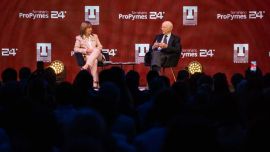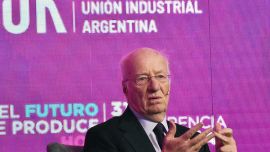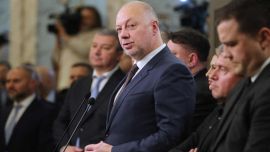Javier Milei is trying to stamp out every vestige of Peronism, Argentina’s dominant strain of populism, in his re-branding of the nation as a free-market haven.
Images of Eva Perón were torn off the walls of government offices; statues of late president Néstor Kirchner were carted out of the Senate and the ANSES social security agency; and just a couple weeks ago, a yellow crane ripped Kirchner’s name off the façade of a giant Beaux Arts palace in downtown Buenos Aires like a dirty old band-aid.
But Milei has had more success tearing down physical symbols of the old guard than he’s had untangling the web of red tape it left behind. For all his promises of speedy dollarisation and shutting down the Central Bank, the ‘cepo’ — a complex system of currency and capital controls that deters investment — remains firmly in place.
During Milei’s first full year in office, Argentina attracted less than US$1 billion in direct foreign inflows. That’s about in line with his Peronist predecessor during the pandemic and only a third of what market darling Mauricio Macri pulled in with less ambitious budget cuts, a lower popularity rating and fewer trips abroad.
While global investors are watching closely, “they remain in wait and see mode,” Mariana Gallo, general manager of PepsiCo Inc in Argentina and Uruguay, told Bloomberg News during a panel discussion in Buenos Aires. “If I can show, not tell, my headquarters that Argentina is a lot better in terms of regulation and taxes, investments will come because the room to grow is extremely attractive.”
The obstacles Milei faces are personified by Cristina Fernández de Kirchner, who succeeded her husband as president in 2007 and then imposed capital and currency controls during her second term. Those restrictions mean companies can’t send dividends abroad while the peso is carefully managed by the Central Bank.
Morgan Stanley estimates that without them, Argentina could attract US$2.5 billion in foreign investment in 2025 alone. But before their removal can see the economy take off “like a scuba diver’s fart” — as Milei has promised time and again — companies will first look to send their trapped riches home, which could spark a currency run and imperil the president’s success in taming inflation.
Milei is hesitant to relax the restrictions ahead of a midterm election in October that will send a crucial signal to investors on whether voters are willing to keep backing his free-market austerity agenda or turn back to Peronism’s money-printing ways. Negotiations on Argentina’s new programme with the International Monetary Fund — the 23rd rescue package in its long and troubled history — also revolve around how and when to unravel controls without fanning inflation.
“If Milei obtains a stronger political mandate in the midterms, it should enhance the government’s ability to pass structural reforms,” according to Kathryn Exum, co-head of sovereign research at Gramercy Funds Management.
When Macri came to power at the end of 2015, it seemed Peronism — the mostly left-leaning, nationalist movement that has governed the country for roughly half of the last seven decades — was on its last legs. The country had endured 12 years under the Kirchners that saw tariffs raised, massive deficits run, investors unpaid and economic data manipulated.
He lifted controls and unified the foreign exchange rate, but policy zigzags two years later collided with a severe drought that walloped crop exports, plunging the peso so much that he eventually brought back restrictions. Fernández de Kirchner returned as vice president in 2019 under her hand-picked boss, Alberto Fernández (no relation), who only hardened those controls before his economy minister was defeated by Milei, a libertarian outsider, in 2023.
“There’s hope with Milei, but no-one is willing to invest in production today,” said Pablo Tamburo, chief executive officer of Argensun SA, a food company that mainly exports sunflower seeds, nuts and dried fruits. “Investors are constantly wondering: Will another government just come in that turns the country 180 degrees once again?”
Tamburo’s company does about US$120 million in annual sales and reduced headcount to 700 employees from 800 last year. One of his clients in Spain was poised to invest US$5 million in a production line, but balked in December after seeing its potential profitability deteriorate as the peso strengthened under Milei’s carefully managed currency policy, while onerous taxes, tariffs and frequent union strikes persist.
In addition to shutting down ports and transportation, organised labour demonstrations often parade in front of Argentina’s former public works ministry, located between Congress and the presidential palace. Milei considered demolishing the building, which features Eva Perón’s face on its side and towers over the main boulevard in Buenos Aires, but opted against it due to cost concerns.
It also took him nearly a year to remove his late predecessor’s name from the million-square-foot former postal hub a few blocks from his office at the iconic Casa Rosada. The government announced the building would be renamed last March and it was officially rechristened Palacio Libertad in October. But the words Centro Cultural Kirchner were still there atop libertarian purple banners until last month.
Fernández de Kirchner, meanwhile, remains a dominant figure in the Peronist movement. The proportion of respondents who view her positively surged to 41 percent in the most recent AtlasIntel poll for Bloomberg News, from 28 percent in December. The US government’s decision to ban her from entering the country over a corruption conviction also risks further polarising Argentina’s electorate ahead of the midterms.
All that has analysts warning not to count Peronism out. “Governments have been notorious for ripping up the rules of the game,” said Steven Levitsky, a Latin American Studies professor at Harvard University. “If I had anything riding on the future of Argentina, I would bet on another round of political instability or institutional change.”
To be sure, Milei’s government has received applications for about US$12 billion in investments in the oil and gas, lithium and infrastructure sectors through a benefits package meant to offer long-term protection from taxes and capital controls. But it’s mostly homegrown companies that have bought in so far, with the notable exception of mining giant Rio Tinto Group, which has pledged US$2.5 billion. Meanwhile, 2024 saw a slew of companies sell off operations in Argentina or leave outright, including HSBC, Procter & Gamble and Exxon Mobil.
“These are not decisions that are made overnight, even more so in countries with Argentina’s economic history,” Diego Sucalesca, who leads the government’s new investment and international trade agency, said of the dearth of foreign investment.
While Sucalesca highlighted the government’s swift efforts to straighten out the country’s macroeconomic imbalances and its efforts to attract foreign capital through the programme, known as RIGI, many investors remain wary.
Diego Ferro, founder of M2M Capital in New York and a long-time skeptic of Argentina bonds, is one of them. “The fact that you had to change everything and that it’s so easy to change everything,” he said, “begs the question: How certain are we that the change is definitive?”
by Manuela Tobias, Bloomberg























Comments